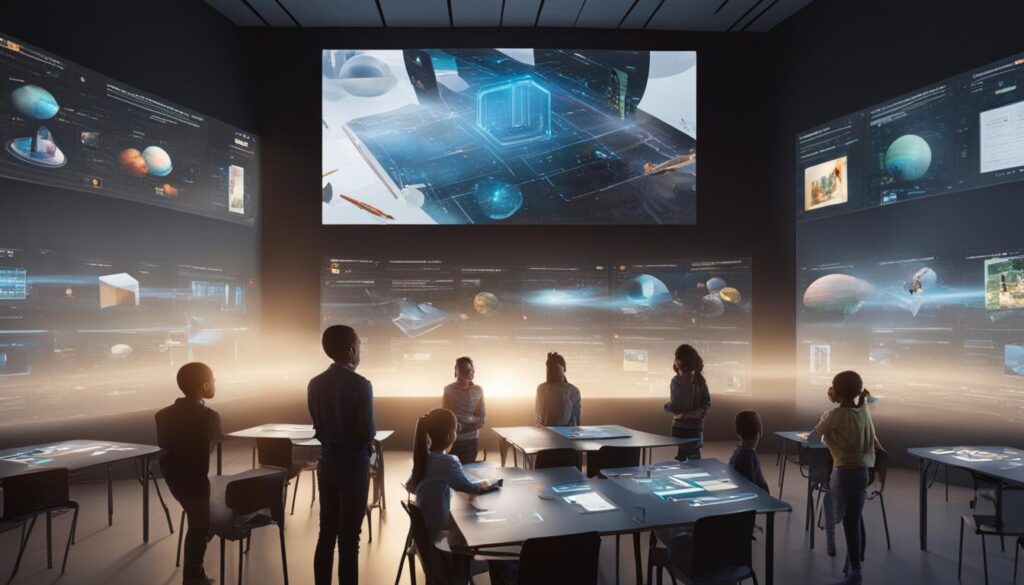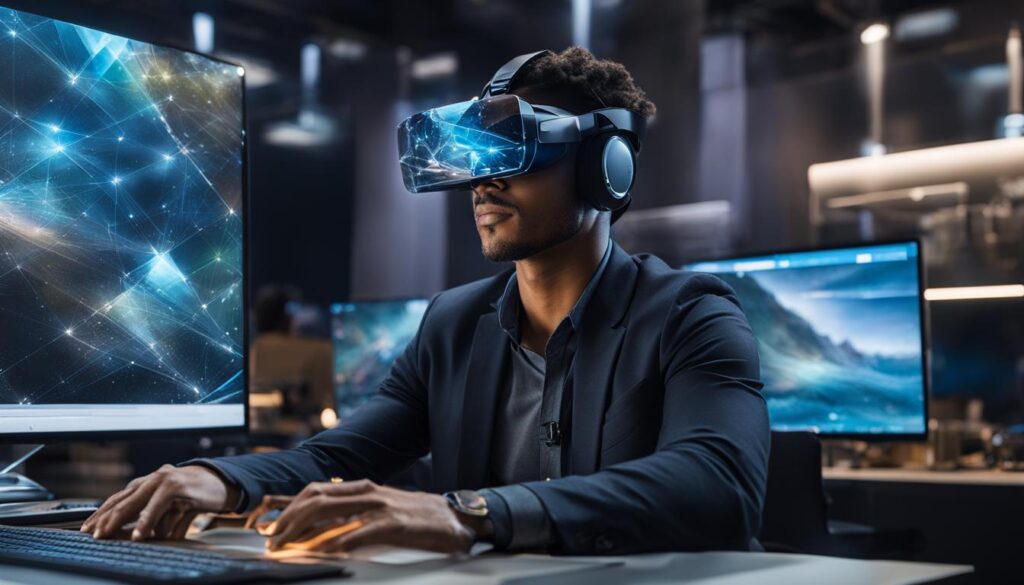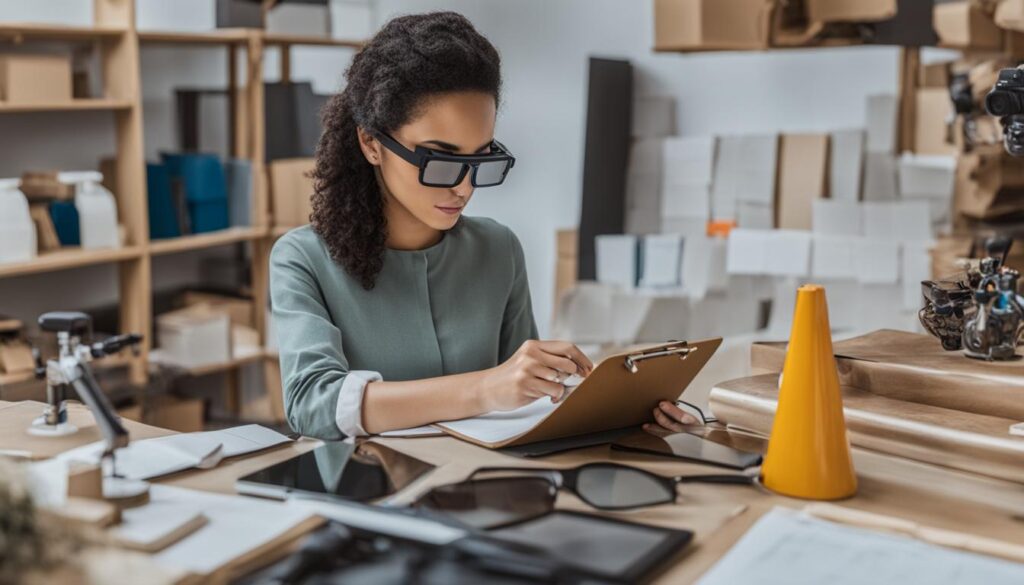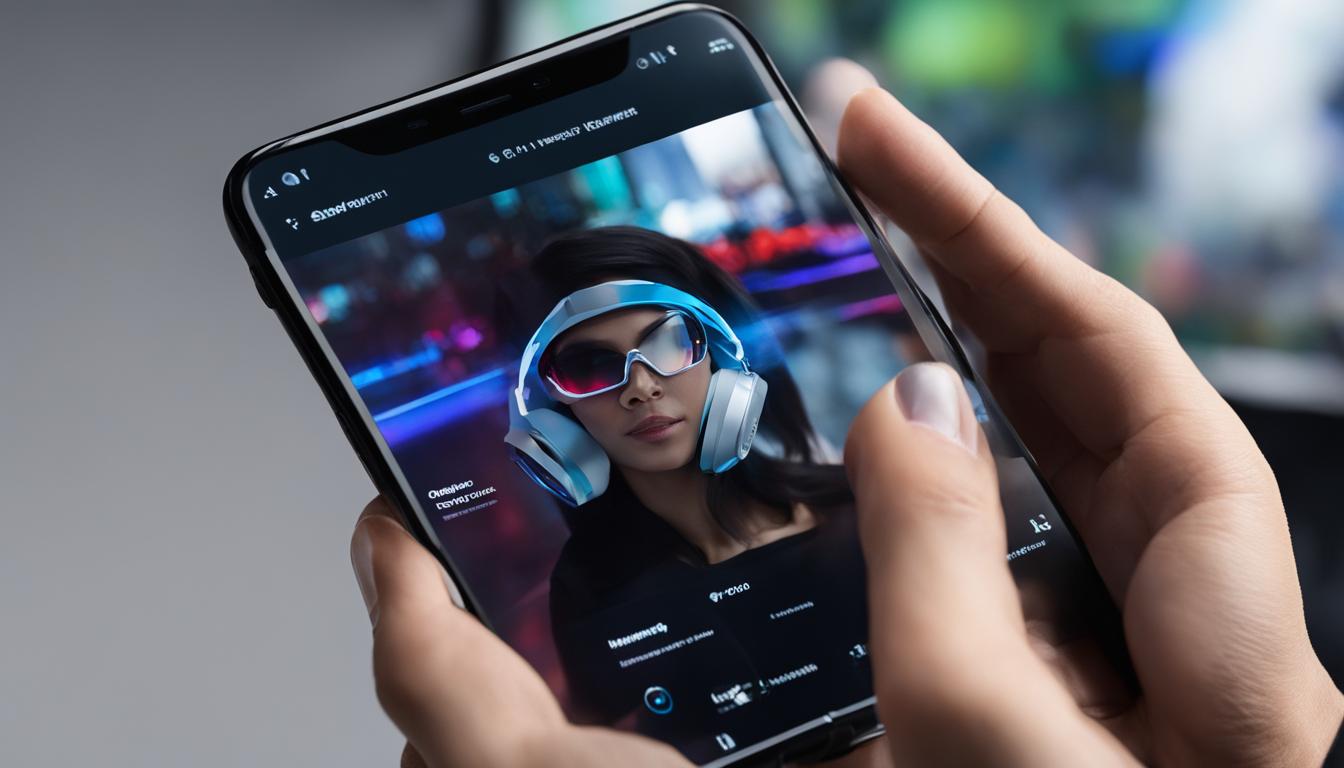Welcome to the future of technology, where augmented reality (AR) revolutionizes how we perceive and interact with the world.
AR technology, along with virtual reality (VR) technology, is an emerging technology that combines virtual elements with the real world, creating immersive digital experiences and transforming various industries.
Contents [hide]
- 1 The Advancements in AR Headsets
- 2 The Potential of AR in Education and Learning
- 3 The Impact of AR on Daily Life
- 4 The Future of AR and Its Challenges
- 5 The Role of Perceptual Research in AR Development
- 6 Conclusion
- 7 FAQ
- 7.1 What is augmented reality (AR), and how does it differ from virtual reality (VR)?
- 7.2 What are some notable advancements in AR headsets?
- 7.3 How can augmented reality transform education and learning?
- 7.4 How can AR technology impact daily life?
- 7.5 What does the future of AR hold?
- 7.6 What role does perceptual research play in AR development?
- 8 Source Links
Key Takeaways
- AR technology is an emerging technology that combines virtual elements with the real world.
- AR has the potential to transform various industries and create immersive digital experiences.
- AR and VR technologies are shaping the future of technology.
- AR can enhance education and learning by creating immersive experiences and interactive simulations.
- AR technology has the potential to seamlessly integrate into our daily lives, enhancing entertainment and providing new ways to engage with information.
The Advancements in AR Headsets
AR headsets are revolutionizing how we experience augmented reality, bringing digital elements into our real-world surroundings. With remarkable technological advancements, AR headsets are becoming more powerful and immersive, offering incredible entertainment, education, and productivity possibilities.
“AR headsets have made significant strides in addressing the perspective problem, delivering more accurate and realistic augmented reality experiences.”
One notable advancement in AR headsets is the Meta Flamera. This headset features a unique “lightfield passthrough” design that improves the accuracy of AR passthrough, seamlessly blending virtual objects with the real world.
The Meta Quest Pro, Microsoft HoloLens, and Magic Leap are noteworthy headsets that have significantly overcome the perspective problem, providing users with a more immersive and seamless experience.
Also read: Can You Visit Other Countries with Augmented Reality?
Comparison of Key Features
| AR Headset | Unique Feature |
|---|---|
| Meta Flamera | Lightfield passthrough for accurate AR integration |
| Meta Quest Pro | Advanced tracking and gesture recognition |
| Microsoft HoloLens | Immersive holographic experiences |
| Magic Leap | High-quality spatial mapping and depth perception |
The innovations in AR headsets don’t stop there. Apple is set to make a significant impact in the AR arena with its upcoming Vision Pro headset. It is highly anticipated for its powerful features and innovative technology, which will further push the boundaries of augmented reality.
With these advancements in AR headsets, the possibilities are endless. Whether exploring virtual worlds, improving productivity, or enhancing educational experiences, AR headsets are shaping the future of augmented reality and transforming how we interact with the digital world.
Also read: Best Tool for Creating Augmented Reality Experiences
The Potential of AR in Education and Learning
Augmented reality (AR) has immense potential in education and learning. With its ability to merge virtual elements with the real world, AR can create immersive experiences beyond traditional classroom settings.
Through AR, learners can visualize abstract ideas, interact with 3D models, and engage in hands-on simulations, enhancing learning.
AR enables learners to stay grounded in their physical reality while enjoying an augmented layer of information and experiences. This unique combination provides a powerful tool for educators to deliver engaging and interactive lessons that cater to different learning styles. AR fosters a more immersive understanding and retention of knowledge by providing a more immersive experience.
One of the critical benefits of AR in education is its ability to enhance creative skills. Through visualization and interactivity, AR allows students to explore their imagination and transform abstract concepts into tangible representations.
For example, students studying astronomy can use AR to visualize celestial bodies and planetary systems in a more interactive and captivating way.
AR has the power to transform learning journeys and enhance creative self-expression, opening up new possibilities for educational experiences.
Furthermore, AR provides opportunities for hands-on simulations that bridge the gap between theory and practical application. For instance, medical students can use AR to simulate surgical procedures, providing a safe and realistic environment for practice.
Similarly, engineering students can design and manipulate 3D models in AR to gain a better understanding of complex structures and systems.
With the integration of AR into education, students can actively participate in their learning process, making it more engaging and personalized. They can explore and interact with virtual content, collaborate with peers, and develop critical thinking and problem-solving skills.
Overall, the potential of AR in education and learning is vast. It offers a transformative approach beyond traditional teaching methods, providing immersive experiences, enhancing visualization, and fostering creative skills.
AR has the power to revolutionize the education landscape, empowering students to become active learners and preparing them for future challenges.

| Benefits of AR in Education and Learning | Examples |
|---|---|
| Enhancing visualization of abstract ideas | Visualizing complex chemical reactions |
| Interacting with 3D models | Exploring ancient monuments in history classes |
| Engaging in hands-on simulations | Simulating archaeological excavations |
| Fostering creative self-expression | Creating virtual art galleries |
| Promoting collaboration and critical thinking | Virtual group projects and problem-solving activities |
The Impact of AR on Daily Life
As AR technology matures, it has the potential to integrate into your daily routines seamlessly. Whether enhancing your at-home experiences or transforming how you interact with your environment, augmented reality applications offer new and exciting possibilities for everyday life.
Imagine creating an immersive workstation right in your own home. With AR, you can transform your desk into a virtual workspace with interactive displays, 3D models, and intuitive controls. It’s an innovative way to stay productive and organized while enjoying a dynamic and immersive work environment.
But it’s not all about work. AR also brings a new level of entertainment to your daily life. Step into the world of your favorite movies, TV shows, or games with augmented reality experiences that blend reality and fantasy.
From interactive storytelling to virtual treasure hunts, AR opens up a whole new dimension of entertainment possibilities.
“AR brings a new level of immersion and engagement to your everyday experiences. It’s like having a magic portal to a world where imagination meets reality.”– AR enthusiast
Enhancing Learning and Education
AR is not just for work and entertainment; it’s also a powerful tool for learning. Imagine studying biology with 3D models of the human body or exploring history by walking through ancient ruins without leaving your home. Augmented reality applications can make learning more interactive, engaging, and memorable.
AR provides a unique and immersive learning experience by blending virtual elements with the real world. It lets you visualize complex concepts, interact with virtual objects, and engage in hands-on simulations.
Whether studying STEM subjects or developing creative skills, augmented reality adds a new dimension to your educational journey.
Augmented Reality Applications
The applications of augmented reality are vast and continue to expand. Here are just a few examples of how AR can enhance different aspects of your daily life:
- Home decor: Visualize how furniture and decor items will look in your space before purchasing.
- Fitness and health: Use AR fitness apps to track your workouts and receive personalized coaching.
- Navigation: Get real-time directions and annotations as you explore new places.
- Language learning: Practice speaking and interacting with virtual language tutors.
- Social media: Share augmented reality filters and effects to add a fun and interactive twist to your posts.
With the continuous advancements in AR technology, these applications are just the tip of the iceberg. As augmented reality becomes more integrated into our daily lives, the possibilities for innovative and transformative experiences are limitless.

| Benefits of AR in Daily Life | Examples |
|---|---|
| Enhanced productivity | Creating an augmented reality workstation for seamless multitasking. |
| Interactive entertainment | Immersing yourself in augmented reality games, movies, and TV shows. |
| Engaging learning experiences | Exploring 3D models and interactive simulations in educational apps. |
| Virtual try-on and visualization | Using AR to preview how products will look in real-life situations. |
| Seamless navigation | Receiving real-time directions and information through AR-powered maps. |
As augmented reality continues to evolve and find its place in our daily lives, it’s evident that the impact will be significant. The future is bright for this transformative technology, as it revolutionizes how we work, play, learn, and navigate the world.
The Future of AR and Its Challenges
The future of augmented reality (AR) is full of exciting possibilities. AR is expected to become smaller and more affordable as technology advances, making it accessible to a broader audience. AR will soon become integral to our daily lives, seamlessly blending virtual tools with our reality.
However, the future of AR also comes with its fair share of challenges. One of the major hurdles is addressing AR technology’s visual limitations and artifacts. As users interact with virtual elements in the real world, it’s crucial to ensure a seamless and immersive experience that doesn’t disrupt their perception.
Another challenge lies in improving the overall user experience of AR. This includes addressing issues such as motion sickness, latency, and the learning curve of AR devices. By enhancing these aspects, AR technology can become more user-friendly and seamlessly integrated into our daily routines.
Despite these challenges, the potential of AR remains immense. With the continued advancement of technology, we can expect to see remarkable breakthroughs in augmented reality. As AR evolves, these challenges will be overcome, unlocking the full potential of this transformative technology.
So, while there are obstacles to overcome, the future of AR is bright. As technology becomes more refined and accessible, we can look forward to a world where virtual tools merge harmoniously with our physical environment, revolutionizing how we live, work, and play.
The Role of Perceptual Research in AR Development
Developing augmented reality (AR) systems that seamlessly integrate with our natural visual experience requires a deep understanding of visual perception. This is where perceptual research is crucial in driving innovation in AR development.
Through innovative research and studies, experts gain valuable insights into how our perception works and how AR can effectively enhance it. By addressing the visual limitations and artifacts associated with AR, researchers can make significant advancements in creating immersive and seamless augmented reality experiences.
Perceptual research explores how our brains process and interpret visual information, helping developers design AR applications that align with our natural visual perception. This research aids in overcoming challenges related to depth perception, object recognition, and spatial understanding, resulting in more immersive and realistic AR experiences.
Additionally, perceptual research guides the development of user interfaces and interaction techniques that promote intuitive and effortless interactions within the augmented environment. Researchers can create intuitive interfaces that seamlessly blend the virtual and physical worlds by understanding how users perceive and interact with virtual objects.
This area of research sparks thought-provoking inquiries and poses open questions that pave the way for future explorations in augmented reality. By continuously pushing the boundaries of perceptual research, developers can unlock the full potential of AR and create extraordinary experiences that enrich our lives.

| Research Area | Benefits |
|---|---|
| Depth Perception | Enhanced sense of depth and spatial understanding in augmented environments. |
| Object Recognition | Accurate detection and tracking of objects, improving the realism of AR experiences. |
| Visual Fatigue | Minimization of eye strain and fatigue caused by extended AR usage. |
| Interaction Techniques | Intuitive and natural ways to interact with virtual objects, enhancing user experience. |
| Spatial Mapping | Precise mapping of virtual information onto physical space for seamless integration. |
Conclusion
Augmented reality (AR) is an incredible transformative technology that has the power to reshape various industries and redefine our daily experiences. With advancements in AR headsets, the potential for education and learning, and the integration of AR into everyday life, the future holds exciting possibilities.
AR headsets, like the Meta Flamera, Meta Quest Pro, Microsoft HoloLens, Magic Leap, and the upcoming Apple Vision Pro, are pushing the boundaries of augmented reality experiences. These headsets pave the way for immersive and enhanced reality, addressing the challenges of perspective and accuracy.
The potential of AR in education and learning is immense. It offers students immersive experiences, allowing them to visualize abstract concepts, interact with 3D models, and engage in hands-on simulations. Integrating AR into education can transform learning journeys and nurture creative skills.
As AR technology matures, its impact on daily life will become more evident. It can enhance at-home uses, providing immersive workstations, entertainment, and learning experiences. Augmented reality applications will transform how we interact with our environment, offering new ways to engage with information, entertainment, and creative expression.
Although there are challenges to overcome, such as improving user experience and addressing visual limitations, these obstacles can be surmounted through continuous innovation and leveraging perceptual research. By doing so, augmented reality will continue to evolve, providing immersive experiences that fundamentally change how we see and interact with the world.
FAQ
What is augmented reality (AR), and how does it differ from virtual reality (VR)?
Augmented reality combines virtual elements with the real world, enhancing our perception and creating immersive digital experiences. Virtual reality, on the other hand, creates a fully simulated digital environment that users can interact with.
What are some notable advancements in AR headsets?
Some notable advancements in AR headsets include the Meta Flamera with its unique “lightfield passthrough” design, the Meta Quest Pro, Microsoft HoloLens, Magic Leap, and the upcoming Apple Vision Pro headset.
How can augmented reality transform education and learning?
Augmented reality can create immersive experiences that allow learners to visualize abstract ideas, interact with 3D models, and engage in hands-on simulations, enhancing their learning journeys and creative self-expression.
How can AR technology impact daily life?
AR technology can transform daily routines by offering new ways to engage with information, entertainment, and creative expression. It can create immersive workstations, provide entertainment and learning experiences, and seamlessly integrate into our environment.
What does the future of AR hold?
The future of AR holds endless possibilities, with the technology expected to become smaller and more affordable. This will make AR more accessible and enable the development of virtual tools that seamlessly integrate into our daily lives.
What role does perceptual research play in AR development?
Perceptual research plays a crucial role in driving innovation in AR development. It helps address visual limitations and artifacts associated with AR, leading to advancements in creating immersive and seamless augmented reality experiences.




